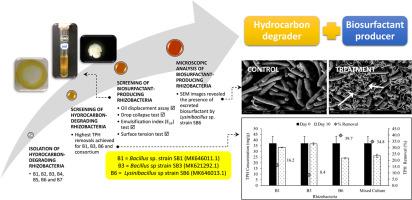Process Safety and Environmental Protection ( IF 6.9 ) Pub Date : 2021-09-09 , DOI: 10.1016/j.psep.2021.09.013 Siti Shilatul Najwa Sharuddin 1 , Siti Rozaimah Sheikh Abdullah 1 , Hassimi Abu Hasan 1, 2 , Ahmad Razi Othman 1 , Nur ‘Izzati Ismail 1

|
Biosurfactant produced by rhizobacteria has the potential to enhance the degradation of hydrocarbons, leading to more efficient phytoremediation. The aim of this work was to search for bifunctional hydrocarbon-degrading and biosurfactant-producing rhizobacteria. Isolation of bacteria was conducted from three sources (A: rhizosphere of Scirpus grossus planted in garden soils and B: rhizosphere of S. grossus planted in crude oil sludge and C: crude oil sludge) prior to degradation test. Seven isolated rhizobacteria from source B (coded as B1–B7) were screened for a hydrocarbon degradation test with an initial total petroleum hydrocarbon content of 56.13 mg/g. Similar isolated rhizobacteria were also found in source A and C. The best three isolates (B1, B3 and B6) and mixed culture of them, significantly degraded hydrocarbon with 16.2%, 8.4%, 39.7% and 34.8% removals, respectively. Subsequently, the three pure rhizobacteria and their mixture (B1 + B3 + B6) were screened for biosurfactant production through tests of oil displacement, drop collapse, emulsification and surface tension. All the pure rhizobacteria and mixed culture had given positive response for all the tests. The presence of biosurfactant produced by rhizobacteria was confirmed by SEM images in which the formation of exopolymers interconnecting individual cells into a complex network of mass was formed due to biosurfactant extraction from bacteria cell. Thus, the three isolated rhizobacteria (B1, B3, and B6), later identified as Bacillus sp. strain SB1, Bacillus sp. strain SB3 and Lysinibacillus sp. strain SB6, respectively, and their mixed culture can simultaneously biodegrade hydrocarbon and produce biosurfactant to enhance the degradation process.
中文翻译:

来自原油污泥的潜在双功能根际细菌用于烃类降解和生物表面活性剂生产
由根际细菌产生的生物表面活性剂具有增强碳氢化合物降解的潜力,从而实现更有效的植物修复。这项工作的目的是寻找双功能碳氢化合物降解和生物表面活性剂产生的根际细菌。细菌的分离从三个来源(进行的:根际藨grossus种植在花园土壤和B:根际S. grossus在降解试验前种植在原油污泥和 C:原油污泥中。对来自来源 B(编码为 B1–B7)的七种分离的根际细菌进行了烃降解试验,初始总石油烃含量为 56.13 mg/g。在源 A 和 C 中也发现了类似的分离的根际细菌。最好的三个分离株(B1、B3 和 B6)和它们的混合培养显着降解碳氢化合物,去除率分别为 16.2%、8.4%、39.7% 和 34.8%。随后,通过驱油、滴塌、乳化和表面张力测试,筛选出三种纯根际细菌及其混合物(B1+B3+B6)生产生物表面活性剂。所有的纯根际细菌和混合培养物对所有测试都给出了阳性反应。根际细菌产生的生物表面活性剂的存在通过 SEM 图像得到证实,其中由于从细菌细胞中提取生物表面活性剂,形成了将单个细胞互连成复杂网络的外聚合物。因此,三种分离的根际细菌(B1、B3 和 B6),后来被确定为芽孢杆菌属。菌株SB1,芽孢杆菌属。菌株SB3和赖氨酸杆菌属。菌株SB6,它们的混合培养可以同时生物降解碳氢化合物并产生生物表面活性剂以增强降解过程。











































 京公网安备 11010802027423号
京公网安备 11010802027423号